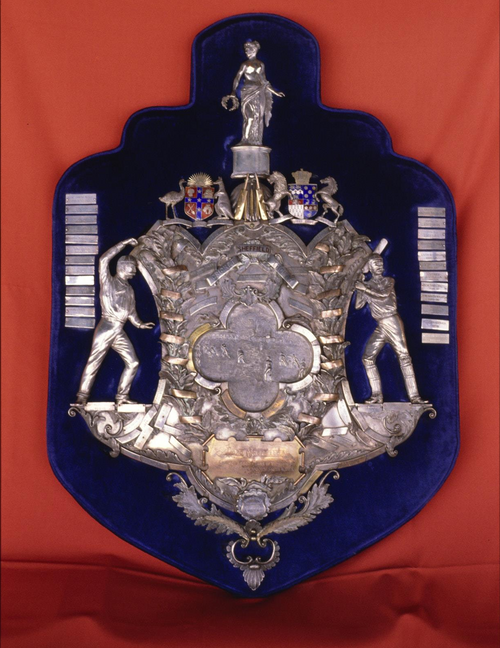By Lorenzo Di-Mauro Hayes, incoming ACS Journalism Scholar (mentored by The Footy Almanac‘s John Harms).
At 3/28 early on the fourth day, South Australia looked far from favourites to lift the Sheffield Shield later in the day. With the bowlers having the upper hand for most of the match, there was not a lot of hope for a successful fourth innings chase at that stage. Despite the situation, an heroic partnership of Alex Carey and Jason Sangha would bring their team to the verge of an historic triumph. It was four days of riveting cricket that had a bit of everything. Changes in momentum, some brilliant performances with bat and ball and the game ended as a record was being broken in the process.
The AFL blocked the hopes of cricket purists and the SA premier who wished to see the Sheffield Shield Final at the Adelaide Oval. As a result, the contest between Queensland and South Australia, , would take place at Karen Rolton Oval. It’s hard to imagine the game would have been better if it was played anywhere else. The local atmosphere felt like something out of Australian sport in the previous century. In addition, a number of Test players took part, which helped this match in a sizeable way.
The final did not get off to the greatest of starts for the visiting side. After losing the toss and being sent into bat, Queensland made just 95 in the first innings, meaning they had a lot of work to do for the rest of the match. The top five batters for the Queenslanders made just 14 runs. Khawaja could only manage 2, and Labuschagne was dismissed for a 7-ball duck. Neither innings helped either man in the hopes of improving their security in the Australian side. Angus Lovell was caught behind for 8, and Jack Clayton like Labuschagne also headed back to the dressing room without scoring after he was run out. As it happened, the two men who were dismissed for zero in the first innings, would make important contributions in the second. Brendan Doggett was the pick of the bowlers taking 6/31 off 11.5 overs, with three maidens and averaging one wicket just under every two overs.
The ball dominated the first day with 16 wickets falling. There was one batsman who was able to brave the conditions. Jake Lehmann’s importance to this match cannot be overstated. His 102-run knock works out to more than a third of all runs scored in South Australia’s first innings. Lehmann scored at a good rate, finding the boundary fifteen times. This was a great batting performance in a game where the ball usually dominated. Benn Manenti on 47 was the next highest scorer and when Lehmann was finally dismissed, the home side was all out for 271 at lunch on Day 2. The game would have looked very different if it was not for Lehmann’s century. With South Australia 176 runs in front and with the ball dominating for the most part, they where firm favourites at this stage.
The second innings for Queensland saw a greater contribution for the big-name Test stars. Khawaja made 21 and Labuschagne worked his way to 61 in a much steadier knock for the long-time Australian number three. But there was no doubt who played the biggest roles at that stage in the game. Jack Clayton and Jack Wildermuth both made triple figures. As a result of a 103-run 7th wicket partnership of Clayton and Wildermuth before a 112-run 8th wicket partnership of Wildermuth and Steketee, the later making 51, the tide of the match had truly turned. Doggett was again so crucial taking a 5-wicket haul from his 35 overs, taking his wicket tally for the match to 11. But Queensland had truly won that innings and had not only scored enough to force South Australia to bat again, but they set a very difficult target. At the start of the fourth day, South Australia needed to make history. If they were successful in chasing down 270, it would be the highest fourth innings run chase ever in a Sheffield Shield final.
The last innings was something truly special. South Australia were reduced to 3/28 early on the fourth morning, and it looked like Queensland was more likely to pull through, in spite of their 95 in the first innings. But the match, which had already seen plenty of great batting duos and brilliant individual performances, had saved the best for the last day. The fourth wicket partnership tallied 202 and brought the Shield back into South Australian hands. The batting performances of Alex Carey and Jason Sangha were among the best fourth innings cricket seen on these shores for some time. Steketee eventually broke the partnership with the wicket of Carey when South Australia where 40 runs away from the target. Queensland picked up a couple of late wickets, but by this point the task was far too big. South Australia broke the record for the largest successful run chase in a Sheffield Shield Final. A boundary off Mitch Swepson levelled the scores and gave us our champion, given South Australia would win the Shield if the final was a draw or tie, before Sangha scored the winning run, putting the cheery on top of the cake.
The scenes after the match looked more like the scenes after an AFL player kicks his 100th goal for the season or when the West Indies won those World Cups in the ‘70s. Footage of the ground invasion after the winning runs were scored, immediately went around the world, earning millions of views across several social media posts. Sangha said from the Pavillion after the match “Seeing the whole crowd run in — it felt like a dream out there, to be honest, it’s special, mate. Words can’t explain it.”
On the following Monday, fans packed out Rundle Mall in Adelaide’s CBD allowing fans a more formal place of celebration. Former Australian fast bowler and South Australian coach Ryan Harris recognised the importance of the win. “It is quite an achievement, what we have done. I am just so proud of this group (and) the belief we have had this year, … and everyone has done it, not just one or two boys, so I am proud of them.” Off the back of first innings figures of 6/31 and second innings figures of 5/109, Brendan Doggett was awarded the Man of the Match award for his role in the victory.
Victorian Scott Boland reflected the thoughts of many regarding the venue this match was played at. “I think (there is a) beauty of playing on grounds that aren’t sort of the main Test venues from our point of view (and) I think it just shows how much the domestic competitions mean to people”. The celebration, the venues, felt from a bygone era. Something that was thought to have been relegated to ‘90s highlights reels only available now on YouTube. The jubilation of your state winning the Sheffield Shield. South Australia had good reason for this, it was the state’s first Shield title since the 1995-96 season. Boland summed it up saying the final was a sign that “domestic cricket is alive and thriving.”
It’s hard to knock that suggestion.
Australian Cricket Society’s literary scholar Lorenzo Di-Mauro Hayes is mentored by writer John Harms. His pieces are also published at www.footyalmanac.com.au .


